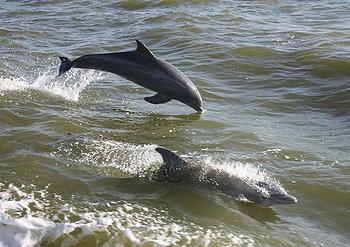
CHAUVIN, Louisiana, August 3, 2013 (ENS) – The 2013 area of low oxygen in the Gulf of Mexico, often called the dead zone, covers an area the size of the state of Connecticut but is still not as large as predicted.
The dead zone off the coast of Louisiana and Texas was measured at 5,840 square miles during this summer’s mapping expedition.
Based on the May nitrogen load from the Mississippi River, the area was predicted to be between 7,300 and 8,600 square miles, depending on the computer model used.
“A near-record area was expected because of wet spring conditions in the Mississippi watershed and the resultant high river flows which deliver large amounts of nutrients,” said Nancy Rabalais, PhD, executive director of the Louisiana Universities Marine Consortium, LUMCON, who led the July 21-28 dead zone survey cruise.

“But nature’s wind-mixing events and winds forcing the mass of low oxygen water towards the east resulted in a slightly above average bottom footprint,” said Rabalais.
The 2013 dead zone is not one of the larger low-oxygen areas mapped since systematic surveys by LUMCON and Louisiana State University researchers began in 1985. Yet the size of this year’s dead zone is above the long-term average and above the average size of the last five years.
The hypoxic zone off the coast of Louisiana and Texas forms each summer, threatening the ecosystem that supports commercial and recreational Gulf fisheries that in 2011 had a commercial dockside value of $818 million and an estimated 23 million recreational fishing trips.
The 2013 Gulf dead zone indicates nutrients from agricultural operations in the Mississippi River watershed are continuing to affect the nation’s commercial and recreational marine resources in the Gulf.
Low oxygen, also called hypoxia, is fueled by nutrient runoff from agricultural and other human activities in the watershed. These nutrients stimulate an overgrowth of algae that sinks, decomposes and consumes most of the oxygen needed to support life.
Usually the low or no oxygen area is found closer to the Gulf floor as the decaying algae settle towards the bottom.
This year researchers found many areas across the Gulf where oxygen conditions were so low at the bottom that animals normally found at the seabed were swimming at the surface.
This is in contrast to 2012, when drought conditions resulted in the fourth smallest dead zone on record, measuring 2,889 square miles, an area just slightly larger than Delaware.
The largest previous dead zone was measured in 2002 at 8,481 square miles. The smallest recorded dead zone measured 15 square miles in 1988.
The average size of the dead zone over the past five years has been 5,176 square miles, more than twice the 1,900 square mile goal set by the Gulf of Mexico / Mississippi River Watershed Nutrient Task Force in 2001 and reaffirmed in 2008.
NOAA’s National Ocean Service has been funding monitoring and research for the dead zone in the Gulf of Mexico since 1985 and currently oversees the NGOMEX program, the hypoxia research effort for the northern Gulf which is authorized by the Harmful Algal Bloom and Hypoxia Research and Control Act.
“NOAA’s investment in the Gulf of Mexico continues to yield results that confirm the complex dynamics of hypoxia and provide managers and the public with accurate scientific information for managing and restoring the nation’s valuable coastal resources,” said Robert Magnien, PhD, director of NOAA’s Center for Sponsored Coastal Ocean Research.
“For those who depend upon and enjoy the abundant natural resources of the Gulf of Mexico,” said Magnien, “it is imperative that we intensify our efforts to reduce nutrient pollution before the ecosystem degrades any further.”
Copyright Environment News Service (ENS) 2013. All rights reserved.
© 2013, Environment News Service. All rights reserved. Content may be quoted only with proper attribution and a direct link to the original article. Full reproduction is prohibited.
